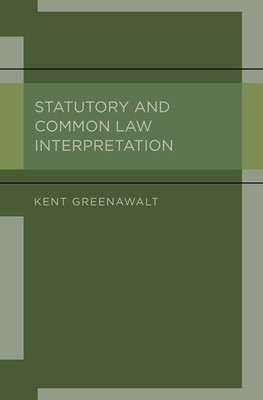
- We will send in 10–14 business days.
- Author: Kent Greenawalt
- Publisher: Oxford University Press, USA
- ISBN-10: 0199756147
- ISBN-13: 9780199756148
- Format: 15.8 x 23.6 x 3.3 cm, hardcover
- Language: English
- SAVE -10% with code: EXTRA
Reviews
Description
As Kent Greenwalt's second volume on aspects of legal interpretation, this book analyzes statutory and common law interpretation and compares the two. In respect to statutory interpretation, it first asks whether judges are "faithful agents" of the legislature or "independent cooperative partners." It concludes that the obvious answer is that neither simple categorization really fits-that the function of judges involves a combination of roles. The next issue addressed is whether the intent of those in authority matters for interpreting the kinds of instructions contained in statutes. At the general level, the answer is "yes." This answer follows even if one thinks interpretation should concentrate on the understanding of readers, because readers themselves would treat intentions as part of the relevant context of the language of statutes. It would take some special reasons, such as constitutional structure or unreliability, to discount actual intents of legislators and use
of legislative history. The book argues that none of these special reasons are convincing. On the question whether judges should focus on the language of specific provision or overall purpose, both are relevant, and purpose should become more important as time passes. In an analysis of various other features of statutory interpretation, the book claims that presidential signing statements should not have weight, that subsequent legislative actions short of new statutes should only occasionally carry importance, that "canons of interpretation," such as the rule of lenity, can provide some, limited, guidance, and that there are special reasons for courts to adhere to precedents in statutory cases, but these should not yield any absolute rule. A chapter on administrative interpretation of statutes claims that the standards agencies apply should differ to a degree from those of courts and that judicial deference to those interpretations is ordinarily warranted.
EXTRA 10 % discount with code: EXTRA
The promotion ends in 20d.09:02:14
The discount code is valid when purchasing from 10 €. Discounts do not stack.
- Author: Kent Greenawalt
- Publisher: Oxford University Press, USA
- ISBN-10: 0199756147
- ISBN-13: 9780199756148
- Format: 15.8 x 23.6 x 3.3 cm, hardcover
- Language: English English
As Kent Greenwalt's second volume on aspects of legal interpretation, this book analyzes statutory and common law interpretation and compares the two. In respect to statutory interpretation, it first asks whether judges are "faithful agents" of the legislature or "independent cooperative partners." It concludes that the obvious answer is that neither simple categorization really fits-that the function of judges involves a combination of roles. The next issue addressed is whether the intent of those in authority matters for interpreting the kinds of instructions contained in statutes. At the general level, the answer is "yes." This answer follows even if one thinks interpretation should concentrate on the understanding of readers, because readers themselves would treat intentions as part of the relevant context of the language of statutes. It would take some special reasons, such as constitutional structure or unreliability, to discount actual intents of legislators and use
of legislative history. The book argues that none of these special reasons are convincing. On the question whether judges should focus on the language of specific provision or overall purpose, both are relevant, and purpose should become more important as time passes. In an analysis of various other features of statutory interpretation, the book claims that presidential signing statements should not have weight, that subsequent legislative actions short of new statutes should only occasionally carry importance, that "canons of interpretation," such as the rule of lenity, can provide some, limited, guidance, and that there are special reasons for courts to adhere to precedents in statutory cases, but these should not yield any absolute rule. A chapter on administrative interpretation of statutes claims that the standards agencies apply should differ to a degree from those of courts and that judicial deference to those interpretations is ordinarily warranted.


Reviews